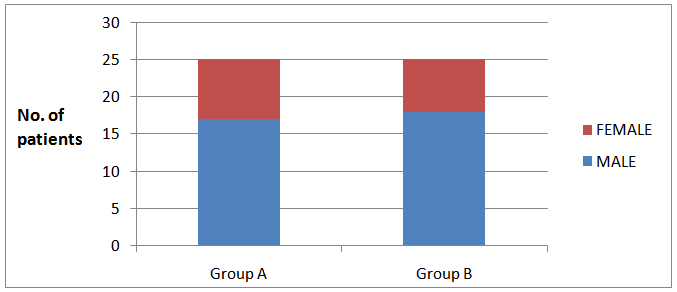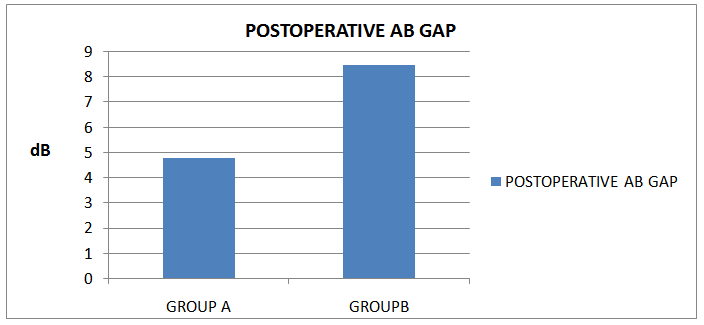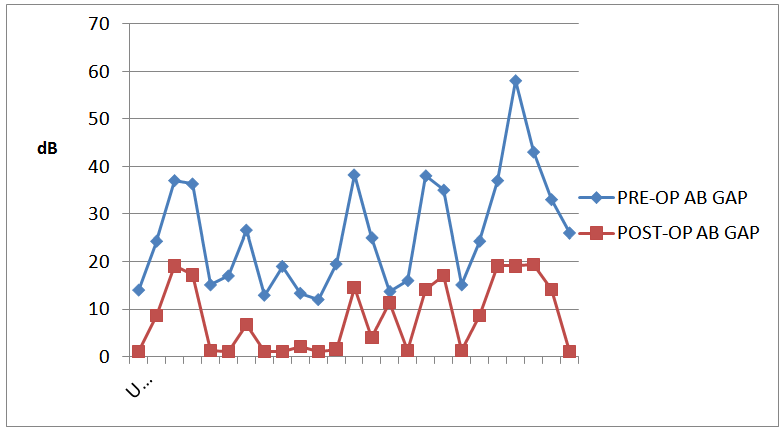-
Paper Information
- Next Paper
- Paper Submission
-
Journal Information
- About This Journal
- Editorial Board
- Current Issue
- Archive
- Author Guidelines
- Contact Us
Research in Otolaryngology
p-ISSN: 2326-1307 e-ISSN: 2326-1323
2014; 3(5): 65-69
doi:10.5923/j.otolaryn.20140305.01
Comparative Study of the Underlay and Over-Underlay Techniques of Tympanoplasty in Perforations of the Tympanic Membrane
Mylanahalli Doddarangaiah Prakash, Borlingegowda Viswanatha, Japneet Kaur, Sataksi Sanyal
Otorhinolaryngology department, Bangalore Medical College & Research institute, Bangalore, India
Correspondence to: Borlingegowda Viswanatha, Otorhinolaryngology department, Bangalore Medical College & Research institute, Bangalore, India.
| Email: |  |
Copyright © 2014 Scientific & Academic Publishing. All Rights Reserved.
Tympanoplasty is defined as a surgical procedure to eradicate disease in the middle ear and to reconstruct the hearing mechanism, with or without mastoid surgery and with or without tympanic membrane grafting. In this study the results of underlay and over-underlay tympanoplasty techniques in tympanic membrane perforations were compared. This randomised prospective study was conducted for a period of 1year [from March 2013 to February 2014]. It included 50 patients who presented to the Otorhinolaryngology department and they were randomly allocated into two groups. In group A, the temporalis fascia graft was placed medial to the handle of malleus (underlay technique), in group B the graft was placed lateral to the handle of malleus but medial to the remnants of the tympanic membrane or fibrous annulus (over-underlay technique). The two groups were followed up for 6 months post operatively. Pre-operative and post operative air-bone gap of the 2 groups were compared. In this study, short-term results of the two tympanoplasty techniques were compared and there was no significant difference found between the two techniques.
Keywords: Underlay techniques, Over-underlay technique, Tympanoplasty
Cite this paper: Mylanahalli Doddarangaiah Prakash, Borlingegowda Viswanatha, Japneet Kaur, Sataksi Sanyal, Comparative Study of the Underlay and Over-Underlay Techniques of Tympanoplasty in Perforations of the Tympanic Membrane, Research in Otolaryngology, Vol. 3 No. 5, 2014, pp. 65-69. doi: 10.5923/j.otolaryn.20140305.01.
Article Outline
1. Introduction
- Tympanic membrane (TM) perforation can result from chronic otitis media, trauma etc. Tympanoplasty is defined as a surgical procedure to eradicate the disease in the middle ear and to reconstruct the hearing mechanism, with or without mastoid surgery and with or without tympanic membrane grafting. Although some surgeons advocate a certain technique for graft placement in a particular situation, it is important to note that the success of any technique depends on how well the technique is performed by the surgeon rather than on the technique itself.In underlay technique, the free edges of the perforation are freshened and the graft is placed medial to the tympanic membrane remnant and handle of malleus (1). However, in over-underlay technique, the graft is placed lateral to the malleus, but medial to the remnants of the tympanic membrane or fibrous annulus.In this study, the two methods of tympanoplasty (underlay and over-underlay technique) were compared.
2. Objectives
- To compare the hearing improvement in both groups by placing the graft medial [underlay technique] or lateral to the handle of malleus [over-underlay technique].
3. Materials and Methods
- A randomised prospective study was conducted for a period of 1 year from March 2013 to February 2014. It included 50 patients who presented to the Otorhinolaryngology department with a small or medium sized central tympanic membrane perforation. They were randomly allocated into two groups of 25 patients each. In group A, the temporalis fascia graft was placed medial to the handle of malleus (underlay technique) while in group B the graft was placed lateral to the handle of malleus but medial to the remnants of the tympanic membrane or fibrous annulus (over-underlay technique).The two groups were followed up for 6 months post operatively. The preoperative and postoperative air bone (AB) gaps in both groups were compared. The success of surgery was defined as complete repair of tympanic membrane perforation without lateralisation, atelectasis or blunting and with post operative hearing gain.
4. Inclusion Criteria
- 1. Age 16-60 years 2. Mucosal type of otitis media with small to medium sized central perforation3. Mild to moderate conductive hearing loss
5. Exclusion Criteria
- 1. Subtotal, total & marginal perforations2. Otitis media with cholesteatoma3. Otitis media with mixed hearing loss4. Patients with hearing loss of more than 60dbThe data collected was analysed using SPSS software trial version 20.
6. Results
- 1. 70% (35) of patients were males while 30% (15) were females. In group A males were 17 and females were 8. In group B males were 18 and females were 7. Mean age of the study population was 30.76 yrs (+/- 10.05) [figure 1A & 1B].2. 52% (26) had small perforation while 48% (24) had medium perforation [figure 2]. In group A 14 patients had small perforation and 11 had medium sized perforation. In group B 12 patients had small perforation and 13 had medium sized perforation.3. Post operative AB Gap was found significant in 74% (37) of patients [Figure 3]. Mean postoperative AB gap in group A was 4.78 and the Mean postoperative AB gap in group B was 8.50.
 | Figure 1A. Showing sex distribution |
 | Figure 1B. Showing the age distribution |
 | Figure 2. Showing type of perforation |
 | Figure 3. Showing mean postoperative gap in group A and group B |
 | Figure 4. Showing preoperative and post operative air bone gap in underlay technique |
 | Figure 5. Showing preoperative and post operative air bone gap in over-underlay technique |
 | Figure 6. Showing preoperative and post operative air bone gap in both groups and P-values |
7. Discussion
- In a retrospective study in Turkey, a total of 104 patients underwent tympanoplasty (via underlay technique in 46 patients and over-under technique in 58 patients). The mean follow-up period was 11 months. In the first group of patients with underlay technique (the graft was placed medial to the remaining drum and the manubrium), the success rate was 91.5%. In the second group with over-under technique (the graft was placed under the remaining drum and over the malleus), the success rate was 94.9%. In the patients operated by the underlay technique, the air-bone gap decreased by 16.55 db. This rate was 16.96 db in those operated via the over-under technique [2].In another study in Michigan Ear Institute, the chosen technique had been over-under tympanoplasty which was performed by placing the graft over the malleus and under the annulus. All their 120 patients had successful grafts. Lateralization of the grafted drum did not occur. Seventeen patients had late atelectasis, and 12 patients had late perforations; nearly all of these were noted more than 1 year after surgery and were attributed to persistent Eustachian tube dysfunction or infections. Average improvement in air-bone gap for all patients was 5.3 dB, whereas speech reception threshold improved by 5.9 dB [3].In another study by Fiorino in Italy, 78 umbus-anchored over-under myringoplasties were performed. They used a large graft with a radial slit distended under the TM and annulus, and the two tongues were positioned to surround the umbus area and overlapped under a non-perforated portion of the TM. Graft take was obtained in 91% of cases and the auditory result showed an average residual air-bone gap of 6.7dB [4]. In Ryan study on 147 patients, overlay graft technique was highly successful for TM repair (98.75%), even in difficult cases [5].The study of Jung concluded medial graft tympanoplasty is suitable for posterior TM perforation, and medio-lateral graft method is excellent for the reconstruction of large anterior or subtotal TM perforation [6]. In a similar study conducted by Mehrdad Rogha et al conducted in Alzahra and Kashani hospitals, between June 2010 and February 2012, 56 patients with chronic otitis media and perforated TM entered the study in two groups. In the first group the graft material was pierced in near central part of the graft and lodged so that the malleus handle projects through the graft perforation while the second group had grafting in the lateral side of the malleus. Three months after surgery both groups were examined and tested by audiometry. Both techniques (medial and lateral to malleus handle) of TM grafting were effective with success rates 96.42% and 92.85% respectively [7].
8. Conclusions
- There is no significant difference in short term results between the two techniques (underlay and over-underlay). We feel over-underlay tympanoplasty is a safe, simple and easy procedure with low rate of graft extrusion and comparable hearing improvement and lesser chance of medialisation of the graft.
 Abstract
Abstract Reference
Reference Full-Text PDF
Full-Text PDF Full-text HTML
Full-text HTML